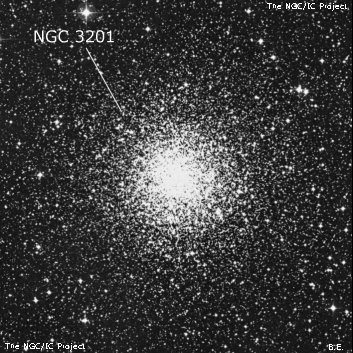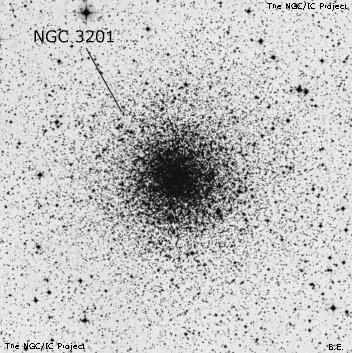NGC/IC Project Restoration Effort
(This is a very very beta version)
NGC3201


Basic Information
Location and Magnitude
Right Ascension: 10:17:36.8
Declination: -46:24:38
Constellation: VEL
Visual Magnitude: 6.9
Historic Information
Discoverer: Dunlop
Year of discovery: 1826
Discovery aperture: 9.0
Observational
Summary description: globular, vL, iR, lCM, st 13…16
Sub-type: X
Steve's Notes
=====
NGC 3201
24" (4/11/08 - Magellan Observatory, Australia): at 200x, this beautiful, loose globular was well resolved with approximately two hundred mag 12 to 16 stars visible within a 10' region. An unusual feature is the large number of brighter cluster stars that appear to be superimposed right on top of a fainter layer of stars in the central core. The core seems displaced towards the north side as if part of the northern half of the cluster was obscured and flattened. This apparent affect may also be due to a larger number of brighter resolved stars that are superimposed on the northern half of the core. A number of stars in the outer halo are arranged in strings and chains and the outer extent of the halo is irregular.
18" (7/8/02 - Magellan Observatory, Australia): beautifully resolved globular at 171x and 228x. The cluster is fairly large, ~8'-10' diameter with more careful viewing. Roughly 150 stars are resolved, though the number grows with magnification and averted vision. A fairly dense layer of brighter mag 11.5-12 stars are resolved right over the bright core. The halo, which has a large number of mag 13 stars, has a scraggly, irregular edge and seems elongated - possibly partially obscured by dust. This concentration class X cluster is 7th in ranking of brightest stars (mag 11.7) and 10th in horizontal-branch mag stars (mag 14.8).
13" (2/23/85): this fairly bright globular cluster appears fairly large and mottled. But only a few stars are resolved due to the view being compromised by the very low elevation (~5ˇ altitude) from northern California.



